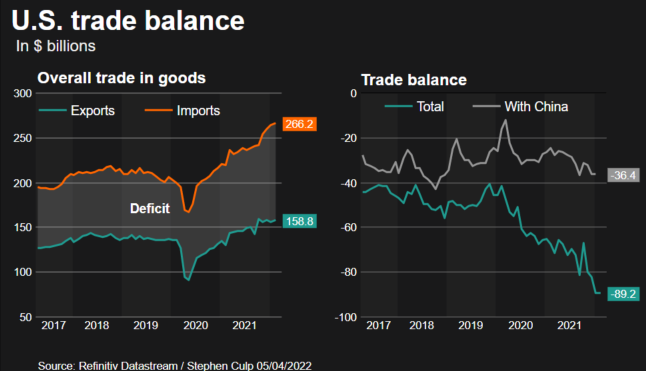U.S. Services Sector Regains Momentum; Inflation Clouds Outlook

U.S. services industry activity picked up in March, boosted by the rollback of pandemic restrictions, but higher prices for fuel and other commodities because of Russia's war against Ukraine are creating uncertainty for many businesses.
The Institute for Supply Management's survey on Tuesday showed capacity constraints and inflation remained major challenges, though the labor crunch had eased. According to Anthony Nieves, chair of the ISM Services Business Survey Committee, the Russia-Ukraine war "has impacted material costs, most notably fuel and chemical prices."
"The services sector is entering the second quarter on strong footing, but two risks continue to cloud the near-term outlook," said Bernard Yaros, an economist at Moody's Analytics in West Chester, Pennsylvania. "The first is Russia's invasion of Ukraine and the second risk remains COVID-19."
The ISM said its non-manufacturing activity index rebounded to a reading of 58.3 last month from a one-year low of 56.5 in February, ending three straight monthly declines. It also signaled a shift in spending back to services from goods.
COVID-19 restrictions have been lifted across the country following a massive decline in infections, unleashing pent-up demand for services like airline travel and dining out. But COVID-19 cases are rising in Europe and China.
Economists polled by Reuters had forecast the non-manufacturing index would rise to 58.4. A reading above 50 indicates expansion in the services sector, which accounts for more than two-thirds of U.S. economic activity.
ISM services PMI:

Prices for commodities like oil, wheat and fertilizer have surged since Russia's Feb. 24 invasion of Ukraine.
Seventeen services industries reported growth, including educational services, arts, entertainment and recreation, as well as utilities, construction, wholesale trade and accommodation and food services. Only agriculture, forestry, fishing and hunting reported a decline.
Businesses in the industry said that "grain and fertilizer prices are near all-time highs, resulting in decreased purchasing." In the construction sector there were complaints that "pricing pressures are stronger than ever due to the Russia-Ukraine war, and energy costs are skyrocketing."
Businesses in the utilities industry reported they were "still seeing raw material subcomponent shortages, transportation delays and price increases." Similar views were shared by their counterparts in the wholesale trade sector who said inflation was worsening, but noted that "overall sales and profitability continue to be strong."
The ISM's measure of new orders received by services businesses rebounded to a reading of 60.1 from a 12-month low of 56.1 in February.
Its services industry employment gauge jumped to 54.0 after dropping to a 1-1/2-year low of 48.5 February, which also was the first contraction in the sub-index since January 2021.
The improvement in labor supply was confirmed by March's employment report on Friday, which showed nonfarm payrolls increased by 431,000 jobs last month.
Despite the increase in hiring, services industries made little headway in reducing the backlog of unfinished work.
That meant services inflation pushed higher. The survey's measure of prices paid by services industries increased to a near record 83.8 from 83.1 in February, indicating that inflation could remain uncomfortably high and elicit an aggressive response from the Federal Reserve.
The U.S. central bank last month raised its policy interest rate by 25 basis points, the first hike in more than three years. On Tuesday, Fed Governor Lael Brainard told a conference at the Minneapolis Fed that "I think we can all absolutely agree inflation is too high and bringing inflation down is of paramount importance."
Stocks on Wall Street were trading lower. The dollar rose against a basket of currencies. U.S. Treasury prices fell.
RECORD TRADE DEFICIT
Surging commodity prices because of the Russia-Ukraine war were evident in a separate report from the Commerce Department, which showed the U.S. trade deficit held at a record high of $89.2 billion in February as both exports and imports increased.
The report added to recent data that showed a moderation in consumer and business spending in suggesting the economy slowed considerably last quarter amid the high inflation triggered by shortages. Economists had forecast a $88.5 billion deficit.
Trade balance:

Exports of goods and services shot up 1.8% to a record $228.6 billion. They were boosted by a 1.8% jump in goods exports, which also hit an all-time high. Petroleum exports hit a record high of $20.3 billion amid soaring crude oil prices.
Exports of consumer goods rose $1.3 billion. But capital goods exports dropped amid a decline in civilian aircraft.
Exports to Ukraine hit a record high, likely reflecting shipments of military equipment. Exports of services increased $1.3 billion to $69.9 billion, lifted by a $1.2 billion rise in travel.
Imports of goods and services jumped 1.3% to an all-time high of $317.8 billion. Imports of goods gained 0.6% to a record $266.2 billion. Imports of industrial supplies and materials were the highest since June 2011. They were fueled by a $1.9 billion surge in crude oil, which averaged $76.37 per barrel, the highest since November 2014.
Imports of both capital and consumer goods hit record highs. Imports of services rose $2.4 billion to $51.6 billion, reflecting increases in charges for the use of intellectual property, transport and travel.
The surge in imports is being fueled by businesses rebuilding inventories, the main driver of gross domestic product growth in the fourth quarter.
"While much of the strength of imports appears to reflect inventory rebuilding, which would normally provide an offsetting boost to growth, the record-setting pace of restocking at the end of last year means that inventories also look set to be an additional drag in the first quarter," said Andrew Hunter, a senior U.S. economist at Capital Economics.
Trade has subtracted from gross domestic product growth for six straight quarters. Growth estimates for the first quarter range from as low as a 0.4% annualized rate to as high as a 2.8% pace. The economy grew at a 6.9% pace in the fourth quarter.
© Copyright Thomson Reuters 2024. All rights reserved.




















